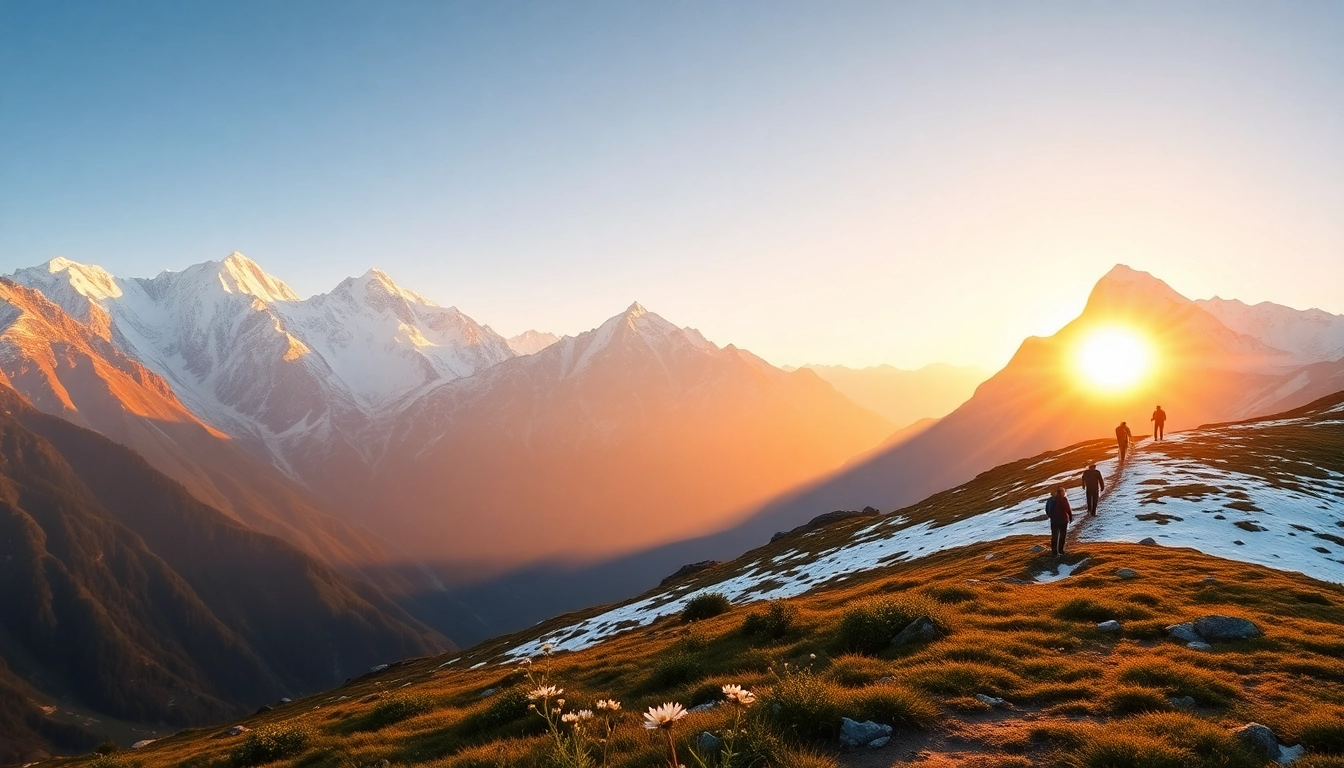Introduction to Annapurna Base Camp Trek
The Annapurna Base Camp Trek is one of Nepal’s premier trekking experiences, offering trekkers an outstanding opportunity to witness the grandeur of the Himalayas while immersing themselves in the rich culture of the local communities. Situated in the Annapurna region, the trek takes you to the base of Annapurna, one of the highest peaks in the world, standing tall at 8,091 meters (26,545 feet). This trek not only promises breathtaking views but also a profound sense of adventure and personal achievement.Annapurna Base Camp Trek provides a unique combination of challenging hikes and serene landscapes, making it suitable for both novice and seasoned trekkers alike.
What to Expect on the Trek
During the Annapurna Base Camp Trek, hikers can expect a mixture of stunning natural beauty, diverse ecosystems, and interactions with local cultures. The journey typically spans approximately 7 to 12 days depending on the chosen itinerary and includes significant elevation changes as you ascend towards the base camp, offering spectacular views of Annapurna’s majestic peaks along the way. Trekkers will pass through picturesque villages, terraced fields, and lush forests, arriving at the base camp with memorable experiences and breathtaking panoramas.
Best Time to Trek Annapurna Base Camp
The best times to embark on the Annapurna Base Camp Trek are generally regarded as spring (March to May) and autumn (September to November). During these seasons, the weather is typically mild, with clearer skies and stable temperatures, making for ideal trekking conditions. In spring, wildflowers bloom, adding vibrant colors to the landscape, while autumn provides striking views of the surrounding peaks. Summer monsoons can bring heavy rainfall, and winter trekking can be challenging due to cold temperatures and snow.
Difficulty Level of Annapurna Base Camp Trek
The trek is considered moderate to challenging, making it accessible for those in good physical condition. However, the significant altitude gain, reaching approximately 4,130 meters (13,550 feet) at base camp, requires careful acclimatization. It’s essential for trekkers to prepare adequately, both physically and mentally, to tackle the demands of high-altitude trekking. The trek involves long days of hiking, often on steep trails, which can test even seasoned trekkers. Moreover, altitude sickness can be a concern, necessitating familiarization with its symptoms and preventative measures.
Detailed Itinerary for Annapurna Base Camp Trek
Day-by-Day Breakdown
A typical itinerary for the Annapurna Base Camp Trek spans around 8-12 days, depending on the route taken and the chosen pace. Below is a breakdown of what a standard itinerary may look like:
- Day 1: Arrival in Kathmandu – Explore the capital’s rich culture and history.
- Day 2: Drive or Fly to Pokhara – Journey to the beautiful town of Pokhara, the gateway to the Annapurna region.
- Day 3: Drive to Nayapul and Trek to Tikhedhunga or Ulleri – Start the trek through lush forests and charming villages.
- Day 4: Trek to Ghorepani – Ascend to Ghorepani, known for its sunrise views from Poon Hill.
- Day 5: Early Morning Trip to Poon Hill, then Trek to Tadapani – Witness the sunrise over the Himalayas.
- Day 6: Trek to Chhomrong – Journey through picturesque landscapes and terraced fields.
- Day 7: Trek to Bamboo – Continue into the Modi Khola valley.
- Day 8: Trek to Deurali – Ascend further, preparing for the final push to base camp.
- Day 9: Trek to Annapurna Base Camp – Reach the stunning Annapurna Base Camp, surrounded by towering peaks.
- Day 10: Return to Bamboo – Begin the trek back, retracing your steps.
- Day 11: Trek to Chhomrong
- Day 12: Trek to Jhinu Danda and relax in hot springs
- Day 13: Trek to Nayapul and drive back to Pokhara
- Day 14: Return to Kathmandu
Highlights of Each Trekking Day
Each day of the trek offers unique highlights that captivate trekkers:
- On the initial days, the trek introduces you to elegant waterfalls, terraced fields, and quaint villages like Tikhedhunga and Ulleri.
- Ghorepani provides iconic sunrise views over Annapurna and Dhaulagiri ranges, seen best from Poon Hill.
- As you continue through Chhomrong to Bamboo, the trail offers diverse flora and fauna, giving visitors a taste of the rich natural heritage of the Annapurna Conservation Area.
- The final ascent to Annapurna Base Camp rewards trekkers with unrivaled views of the Annapurna massif, creating an unforgettable, immersive experience in the grandeur of the mountains.
Alternative Routes to Annapurna Base Camp
While the traditional route to Annapurna Base Camp is popular, there are alternative paths that vary in terms of scenery and experience, such as:
- The route via Ghandruk: A shorter trek offering stunning views while allowing trekkers to engage with local Gurung culture.
- The Annapurna Sanctuary trek: A less traveled path that explores both the natural beauty and cultural richness of the region.
- The Via Poon Hill: Incorporating sunrise views over the Himalayas while enjoying the beauty of Rhododendron forests.
Preparing for Your Annapurna Base Camp Trek
Essential Gear and Packing Tips
Proper preparation is vital for a successful trek. Key items to pack include:
- Clothing: Layered clothing for varying temperatures, waterproof jackets, thermal underwear, and trekking pants.
- Footwear: Sturdy trekking boots that provide ankle support, along with sturdy socks.
- Backpack: A daypack for daily use, accommodating essential items and personal gear.
- Sleeping Gear: If camping, bring a quality sleeping bag suitable for cold weather.
- Health Essentials: First aid kits, altitude sickness medicines, and personal medications.
Physical Preparation and Training
Preparing physically for the Annapurna Base Camp Trek is essential. Trekkers should engage in cardiovascular workouts such as hiking, running, or cycling to build stamina. Incorporating strength training and flexibility exercises will also be beneficial, focusing on leg, core, and back strength. Ideally, a training schedule should begin several months prior to the trek.
Health and Safety Considerations
Altitude sickness is a potential risk during the Annapurna Base Camp Trek. Understanding its symptoms and potential treatments is crucial for ensuring safety. Symptoms may include headache, nausea, dizziness, and fatigue. It is imperative to ascend gradually, allowing for proper acclimatization and hydration throughout the trek. Carrying a basic first aid kit and knowing how to use it can prove invaluable.
Cost of Trekking Annapurna Base Camp
Budgeting for Your Trip
The cost of the Annapurna Base Camp Trek varies depending on factors like the duration, guide services, and accommodation choices. Typically, a budget trek can cost around USD 500 to USD 1200, while more luxurious options may run higher. It’s wise to plan and budget accordingly, accounting for flights, gear, food, permits, and additional expenses.
Understanding Permits and Fees
To trek in the Annapurna region, trekkers require two permits: the Annapurna Conservation Area Permit (ACAP) and the Trekkers’ Information Management System (TIMS) card. Collectively, these permits typically cost around USD 50-70. It’s essential to acquire them beforehand to avoid delays in your trekking schedule.
Value for Money: Services Included
When budgeting for the trek, it’s important to consider the value of included services such as guides and porters, accommodation, meal packages, and local cultural experiences. Hiring experienced guides and porters not only enhances safety but also enriches the trekking experience through their local knowledge and support.
Tips for an Enjoyable Annapurna Base Camp Trek
Local Culture and Etiquette
Understanding and respecting local cultures is vital when trekking in Nepal. This region is home to various ethnic groups with their own customs. Engaging with locals and learning about their lifestyle enriches the trekking experience. Basic greetings and phrases in Nepali can greatly enhance interactions and show respect for their culture.
Capturing Memories: Photography Tips
The Annapurna Base Camp Trek offers numerous breathtaking scenery. To effectively capture the beauty, consider these photography tips:
- Utilize natural light; morning and late afternoon provide the best lighting conditions.
- Incorporate local culture into your shots, taking photographs of landscapes alongside local life.
- Experiment with varying angles and compositions to create captivating images of the surroundings.
Sustaining Your Energy: Food and Hydration
Maintaining energy levels is crucial. Traditional meals, featuring Dal Bhat (rice and lentils), provide the necessary carbohydrates and proteins. Staying hydrated is equally essential, with trekkers encouraged to drink at least 3-4 liters of water daily. Purifying water from streams or purchasing purified water bottles can help ensure safety.



